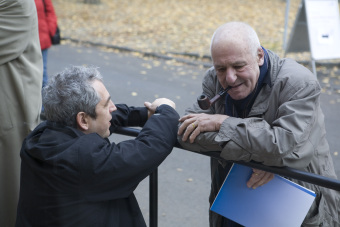Jean-Christophe Ammann, artistic consultant to the Wollheim Commission, in a conversation with artist Heiner Blum

© Jessica Schäfer
“I want to really get through to people!” (Heiner Blum)
Jean-Christophe Ammann: In late 2007, the Wollheim Commission of the Goethe University in Frankfurt am Main appointed you to come up with a concept for a memorial site for Norbert Wollheim and the Buna/Monowitz concentration camp.
Heiner Blum: The university commission wanted a monument that would pay tribute to Norbert Wollheim as an individual and to his accomplishments. Bound up with that was the history of I.G. Farben and its Buna/Monowitz concentration camp, which Norbert Wollheim had survived and where he did forced labor under the worst possible conditions. That led, in the 1950s, to his lawsuit against I.G. Farben i.L., seeking compensation for lost wages. At the university, an initiative had already been organized, and its participants were intensely involved with the range of issues and the appeal for a way to commemorate I.G. Farben’s forced laborers. The members of the initiative were a highly committed student group and staff of the Fritz Bauer Institute. In intensive conversations, it became clear to me that this memorial project could be implemented only by creating a framework for multifaceted access.
Ammann: How did you proceed with that?
Blum: My concept for the memorial brings together several interlocking levels: In the park grounds in front of the I.G. Farben Building, 13 photo panels were set up in the existing clusters of trees. In an epic and emotional form, the photos communicate the theme of the absolute break in the life of the deportees. In addition, I had to find a way to convey the complexity of history and remembrance in a small amount of space—because the former caretaker’s building, which was available on site, could not have housed an appropriate exhibition. For that reason, from the very outset I envisioned “de-placing” the information by putting it on a web site: This way, people who are interested can look into the issues and contexts not only in Frankfurt, but from everywhere in the world. In addition, excerpts from the enormous quantity of materials and documents that the research team came across in the course of its work can be made accessible on the Internet.
Ammann: How have you structured the large amount of information?
Blum: The web site is divided into two levels: On the first are introductory texts about various aspects of subject areas such as I.G. Farben, its Buna/Monowitz concentration camp, features of Norbert Wollheim’s biography, and issues of bearing witness and commemoration. A second level contains scholarly essays that deal in greater detail with the overarching themes and problems of these subjects. In each case, the materials made accessible there are grouped by subject matter. The interviews can be viewed on the web site, as well as in the memorial pavilion, where two monitor units are located.
Ammann: How was the work organized?
Blum: With the support of the President of the University of Frankfurt, representatives of the Claims Conference, the Fritz Bauer Institute, survivors, and well-known foundations, a project office was created, and a group of scholars worked there on researching and arranging the material. In addition, 24 survivors of the Buna/Monowitz concentration camp were willing to take part in a video interview and discuss their personal histories.
All this information is made accessible for visitors to a former caretaker’s pavilion—which, like the I.G. Farben Building, was built according to Hans Poelzig’s blueprints—and on a web site. In addition, a work area for research is being set up in the university library.
Ammann: So the memorial will consist of three parts. Besides the web site and the pavilion, there are the photo panels on the grounds, as we mentioned earlier. How do they relate to the rest of the concept?
Blum: I wanted to find a low-key way of access for the users of the building. The photographs don’t show images of horror, to which many people react with apathy, but ordinary moments from the time before the persecution began: happy scenes of family closeness, children playing exuberantly, friendly get-togethers. They were robbed of this happiness, and it was systematically destroyed: The people shown in the photos perished in the Buna/Monowitz concentration camp or barely escaped with their lives.
In choosing the pictures, I thought it was important to capture the essential element of the collective biography. For the observers, the scenes in the photos could be part of their own lives—I want to really get through to people! Nevertheless, you have to be aware that the subjects of the photos were enslaved, beaten to death, or gassed.
A red number engraved on the images indicates that they were robbed of their names after arriving at Auschwitz and addressed from then on only by the numbers tattooed on their arms.
Ammann: This approach surely continues with the pavilion.
Blum: Yes, the link between the photo panels and the pavilion can be clearly seen. Above the entrance of the building, you read Norbert Wollheim’s prisoner number in exactly the same typography and technical execution as the name of Johann Wolfgang Goethe, which appears above the nearby university portal.
The interior of the pavilion was redesigned in a simple way: The furnishings are deliberately restrained, so that larger groups like school classes also can be accommodated. In addition, however, anyone who is interested can call up the various categories of information individually, using the two screens available there. Set into the wall facing the entrance, in large type, are Norbert Wollheim’s words: Wir sind gerettet, aber wir sind nicht befreit (“We have been saved, but we are not liberated”). The sentence carried conviction also because of its simplicity, behind which the enduring traumas of those who survived the concentration camps become imaginable.
(Transl. KL)
















